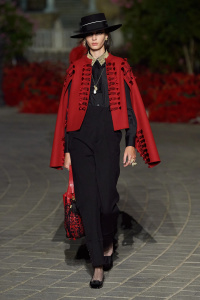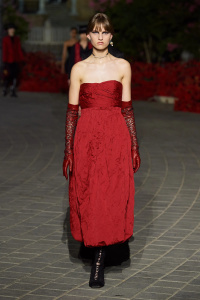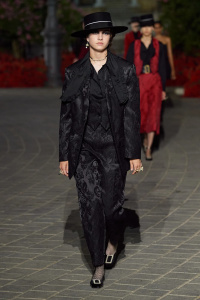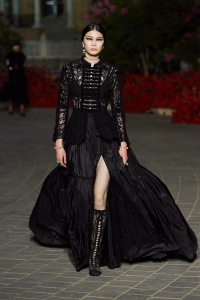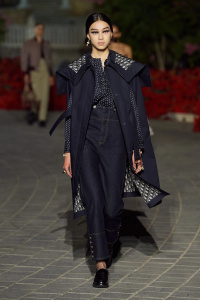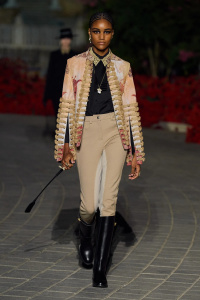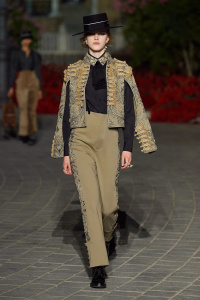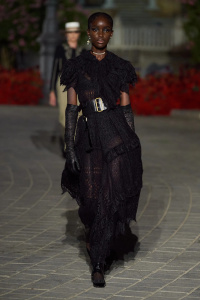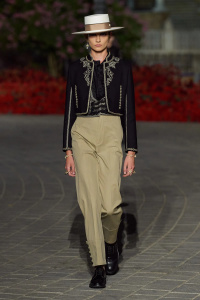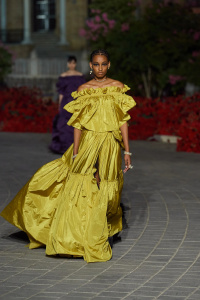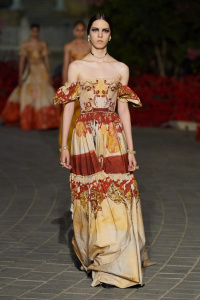-
Watch Live! The 2025 VS Fashion Show.
You are using an out of date browser. It may not display this or other websites correctly.
You should upgrade or use an alternative browser.
You should upgrade or use an alternative browser.
Christian Dior Cruise 2023 Seville
- Thread starter Frederic01
- Start date
TianCouture
Well-Known Member
- Joined
- Jun 26, 2009
- Messages
- 1,324
- Reaction score
- 1,263
definitely not fuego. definitely fueg-no.
D
Deleted member 7575
Guest
She has a 3 years contract and it was renewed in 2019. But I'm not sure, maybe LVMH will renew it again based on her commercial success. They did renew Nicolas's contract after all.
MGC is a cash cow. She's nearly tripled their revenue since she started. Unless she has absurd or impossible demands for her new contract, I would not expect her to go anywhere anytime soon.
D
Deleted member 7575
Guest
It is so Ralph Lauren... and so repetitive and dull palette.
VERY Ralph.
jeanclaude
Well-Known Member
- Joined
- Feb 12, 2012
- Messages
- 4,597
- Reaction score
- 13,283
Ok, as a spaniard this reminded me of the "Día de la Hispanidad" show in 90s "Telecinco" TV channel (sponsored by the Sevilla Town Hall). It sure does not feel as a Dior fashion show at all.
Apart from the logos, I can´t see Dior here. Only her generic clothes covered by typical spanish ornaments here and there.
This is as kitsch as buying a bullfighting figurine in a novelty store (an expensive one, in this case). Pure "tourist trap" material!
Right now at the Fashion Institute of Technology in N.Y. there´s an interesting expo:“Dior + Balenciaga: The Kings of Couture and their Legacies”.
It would have been interesting to create a collection inspired by the influence of Cristóbal Balenciaga in Christian Dior. A subtle way of approaching the spanish theme, without being as literal as this cruise collection is...but this is Mary, so that´s too much for her to handle!
If Mary keeps working at Dior, next time she launches another cruise collection "inspired" by Spain, she could show it at País Vasco (Basque Country)... and taking the theme of "San Fermines" as inspiration. The clothes would be as boring as always; but it would be very funny seeing the poor models running for their lives, while trying to escape from the bulls!!
Apart from the logos, I can´t see Dior here. Only her generic clothes covered by typical spanish ornaments here and there.
This is as kitsch as buying a bullfighting figurine in a novelty store (an expensive one, in this case). Pure "tourist trap" material!
Right now at the Fashion Institute of Technology in N.Y. there´s an interesting expo:“Dior + Balenciaga: The Kings of Couture and their Legacies”.
It would have been interesting to create a collection inspired by the influence of Cristóbal Balenciaga in Christian Dior. A subtle way of approaching the spanish theme, without being as literal as this cruise collection is...but this is Mary, so that´s too much for her to handle!
If Mary keeps working at Dior, next time she launches another cruise collection "inspired" by Spain, she could show it at País Vasco (Basque Country)... and taking the theme of "San Fermines" as inspiration. The clothes would be as boring as always; but it would be very funny seeing the poor models running for their lives, while trying to escape from the bulls!!
Frederic01
Well-Known Member
- Joined
- Jun 7, 2021
- Messages
- 1,909
- Reaction score
- 4,705
Review from Vanessa Friedman of The New York Times.
nytimes.com/A Really Radical Fashion Idea
When is a cruise show not just a cruise show? Ask Maria Grazia Chiuri of Dior.
By Vanessa Friedman / June 17, 2022

I am beginning to think that Maria Grazia Chiuri, the artistic director of Dior women’s wear, may be the most subversively political, even radical, designer in charge of a big French fashion brand.
Not because of her clothes, which are perfectly pretty, if limited to a handful of familiar forms: full ballet skirts with nipped-in waists and crisp shirting; boy trousers and bar jackets; princess dresses. Or because of her sincere, if sometimes forced, feminism, which occasionally involves a message tee (or banner). But because of her approach.
At least her approach to her cruise shows, which has transformed a destination boondoggle for clients and critics (not this one: The New York Times does not accept free trips) into a destination boondoggle with purpose. Namely to argue, in the most gilded and glamorous terms, that the artisanal heritage of any number of cultures is the equivalent, in skill and value, to that of the Paris couture.
That the French don’t have a monopoly on embroidery and material creativity. That the somewhat derogatory, and often racist, dismissal of “craft” as not up to being considered a decorative art, is outdated and wrong. And that, you know, it’s time to build some bridges, take down the walls.
Zowie. In an industry long predicated on a hierarchy of taste handed down through the decades, that’s a pretty revolutionary idea.
In Ms. Chiuri’s hands, it’s also pretty convincing. Not to mention a much more resonant take on the current craze for collaboration that’s sweeping fashion than the usual you-market-my-back-I’ll-market-yours.
She has been hammering home this thesis consistently and insistently, through shows in Marrakesh, Athens and Puglia, all of which incorporated the work of a host of independent local artisans, whose contributions were listed not just in lengthy pamphlets that accompany each show, but also on the labels inside the garments. (Chanel also showcases the work of “specialist ateliers” in its Métiers d’Art shows, but the ateliers are majority French, and owned by Chanel.)
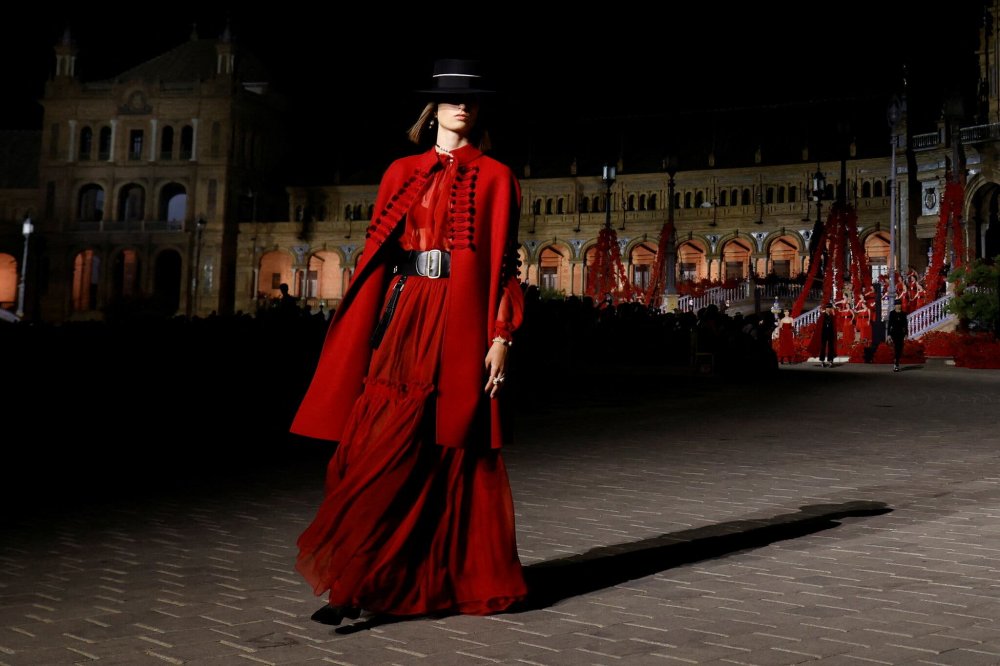
This season the case was made in Seville, Spain, with the work of seven local ateliers — specialists in hat-making, leatherwork, embroidery, fans and metalwork — as well as prints from the artist María Ángeles Vila Tortosa featured against the lavish backdrop of the Plaza de España, now filled with 250,000 crimson roses.
Also an orchestra led by the composer Alberto Iglesias, known for his work with Pedro Almodóvar, and a flamenco troupe with 40 dancers and two soloists under the direction of the choreographer Blanca Li. Plus, of course, some models wearing Ms. Chiuri’s signature Diorisms, filtered through a reference book of matadors and madonnas with the lingering sound of castanets echoing through the seams.
See, for example, pleated black trousers worn with suspenders over a white tank, and draped in a grandly fringed white lace shawl. Peg-leg pants piped in lace with a matching vest worn under a flat-brimmed hat. Skirts richly embroidered in the gold thread used to make vestments for religious ceremonies. Leather gloves, riding crops, belts and chaps.
And a host of jewel-tone, off-the-shoulder taffeta gowns that were a little less obvious than the finale of corseted infanta looks with silhouettes of La Capitana (Carmen Amaya, the first female flamenco dancer to wear a male uniform onstage) by Ms. Tortosa incorporated into the design.
You don’t have to get all the back stories to appreciate the clothes, even the ones that were a little too olé-tastic, but they are additive.
In a Zoom call before the show, I asked Ms. Chiuri why she had taken on this project. (Each cruise show takes six to eight months to prepare, which is significantly more time intensive than a regular ready-to-wear collection.)
“First, it is just a pleasure,” she said. “Second, it’s a responsibility.” Then she said, “If I don’t do it, who can?”
Cocteau Stone
Well-Known Member
- Joined
- Feb 12, 2022
- Messages
- 1,989
- Reaction score
- 4,928
Design Team: "How many off the shoulder numbers do you want?"
Maria: "Yes"
In all serious, I will give some credit to the fabrics, embroideries and textures as they are rather gorgeous thanks to the artisans. But wow, what an utterly stale execution this is and so heavy (especially in visual weight) for a cruise show. It's bit of a disservice to the artisans, where you can feel the passion for their craft come through, to have their work be used for such a collection.
Maria: "Yes"
In all serious, I will give some credit to the fabrics, embroideries and textures as they are rather gorgeous thanks to the artisans. But wow, what an utterly stale execution this is and so heavy (especially in visual weight) for a cruise show. It's bit of a disservice to the artisans, where you can feel the passion for their craft come through, to have their work be used for such a collection.
velvetandsilk
Well-Known Member
- Joined
- Aug 26, 2020
- Messages
- 537
- Reaction score
- 1,138
Editing of the video is simply tragic. Too much of musicants, dancers in disgusting skirts, side views and panoramas, no focusing on collection at all
They do it on purpose. The clothes are not important just creating an atmosphere around the fashion house.
what's the commercial idea behind doing so many looks on the runway?
is it just so they can sell almost the entire collection as 'seen on the runway'?
The price is higher if you show clothes on the catwalk. If they were fair to the customer, half of the collection was shown during trunk shows for buyers.
D
Deleted member 7575
Guest
Review from Vanessa Friedman of The New York Times.
nytimes.com/
Excellent review, thank you for sharing.
blackcherrified
Well-Known Member
- Joined
- Aug 6, 2011
- Messages
- 313
- Reaction score
- 389
On second look… this collection feels more Dolce & Gabbana than Dior
brandon J pierre
Well-Known Member
- Joined
- Jul 21, 2021
- Messages
- 1,174
- Reaction score
- 2,834
where can we see this again?You mean like when he was high as a kite while being interviewed by Tim Blanks after his flamenco/dance collection for Dior?
brandon J pierre
Well-Known Member
- Joined
- Jul 21, 2021
- Messages
- 1,174
- Reaction score
- 2,834
no way this has classOn second look… this collection feels more Dolce & Gabbana than Dior
brandon J pierre
Well-Known Member
- Joined
- Jul 21, 2021
- Messages
- 1,174
- Reaction score
- 2,834
Great production doesn't mean anything if the clothes are not the focus.
This is a great collection. Some looks are really strong. But it gets drowned in 110 looks. I hate when designers sent out more than 100 looks. She has the same problem with Alessandro at Gucci, they don't know how to edit, so they just sent out every single idea that they have.
Cut this collection in half, edit out all those same looks but in different colors, and with better styling. It's can be even better.
This just proved that it's difficult to balance between big production and still make your clothes capture the attention of the audience. Karl is a master of that, no matter how big the production is, his clothes had never been outshined by the set.
Considering this is her last year, I wish she would take more risks.
Karl, Gianni Versace, McQueen and john Galliano are some of the best editors, this is a lot of looks , some are so smiler that it kind of works. remember they have a big store to pack !
Similar Threads
- Replies
- 7
- Views
- 2K
- Replies
- 2
- Views
- 3K
- Replies
- 26
- Views
- 4K
- Replies
- 62
- Views
- 13K
Users who are viewing this thread
Total: 1 (members: 0, guests: 1)


